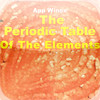The Periodic Table of the Elements
Detailed App Info:
Application Description
This app titled, "The Periodic Table of the Elements" is a tabular display of the chemical elements. The periodic table is now ubiquitous within the academic discipline of chemistry, providing a useful framework to classify, systematize, and compare all of the many different forms of chemical behavior. There are 4 different classifications in the Periodic Table. They are,
Period:
A period is a horizontal row in the periodic table. Although groups are the most common way of classifying elements, there are some regions of the periodic table where the horizontal trends and similarities in properties are more significant than vertical group trends. This can be true in the d-block (or "transition metals"), and especially for the f-block, where the lanthanides and actinides form two substantial horizontal series of elemen.
Group:
A group or family is a vertical column in the periodic table. Groups are considered the most important method of classifying the elements. In some groups, the elements have very similar properties and exhibit a clear trend in properties down the group. These groups tend to be given trivial (unsystematic) names, e.g., the alkali metals, alkaline earth metals, halogens, pnictogens, chalcogens, and noble gases. Some other groups in the periodic table display fewer similarities and/or vertical trends, and these have no trivial names and are referred to simply by their group numbers.
Block:
Because of the importance of the outermost shell, the different regions of the periodic table are sometimes referred to as periodic table blocks, named according to the subshell in which the "last" electron resides. The s-block comprises the first two groups (alkali metals and alkaline earth metals) as well as hydrogen and helium. The p-block comprises the last six groups which are groups 13 through 18 in IUPAC (3A through 8A in American) and contains, among others, all of the semimetals. The d-block comprises groups 3 through 12 in IUPAC (or 3A through 8A in American group numbering) and contains all of the transition metals. The f-block, usually offset below the rest of the periodic table, comprises the lanthanides and actinides.
Other:
The chemical elements are also grouped together in other ways. Some of these groupings are often illustrated on the periodic table, such as transition metals, poor metals, and metalloids. Other informal groupings exist, such as the platinum group and the noble metals.
Period:
A period is a horizontal row in the periodic table. Although groups are the most common way of classifying elements, there are some regions of the periodic table where the horizontal trends and similarities in properties are more significant than vertical group trends. This can be true in the d-block (or "transition metals"), and especially for the f-block, where the lanthanides and actinides form two substantial horizontal series of elemen.
Group:
A group or family is a vertical column in the periodic table. Groups are considered the most important method of classifying the elements. In some groups, the elements have very similar properties and exhibit a clear trend in properties down the group. These groups tend to be given trivial (unsystematic) names, e.g., the alkali metals, alkaline earth metals, halogens, pnictogens, chalcogens, and noble gases. Some other groups in the periodic table display fewer similarities and/or vertical trends, and these have no trivial names and are referred to simply by their group numbers.
Block:
Because of the importance of the outermost shell, the different regions of the periodic table are sometimes referred to as periodic table blocks, named according to the subshell in which the "last" electron resides. The s-block comprises the first two groups (alkali metals and alkaline earth metals) as well as hydrogen and helium. The p-block comprises the last six groups which are groups 13 through 18 in IUPAC (3A through 8A in American) and contains, among others, all of the semimetals. The d-block comprises groups 3 through 12 in IUPAC (or 3A through 8A in American group numbering) and contains all of the transition metals. The f-block, usually offset below the rest of the periodic table, comprises the lanthanides and actinides.
Other:
The chemical elements are also grouped together in other ways. Some of these groupings are often illustrated on the periodic table, such as transition metals, poor metals, and metalloids. Other informal groupings exist, such as the platinum group and the noble metals.
Requirements
Your mobile device must have at least 675.05 KB of space to download and install The Periodic Table of the Elements app. The Periodic Table of the Elements is available on iTunes for $1.99
If you have any problems with installation or in-app purchase, found bugs, questions, comments about this application, you can visit the official website of Saravanan K at http://www.appwings.com/apps/the_periodic_table_of_the_elements.html.
Copyright © 2011 App Wings




